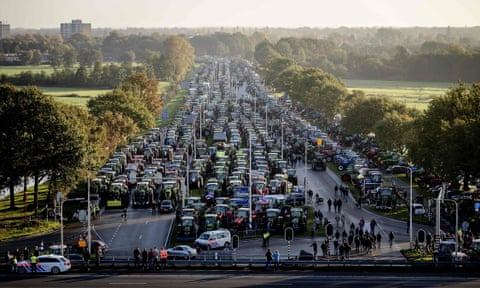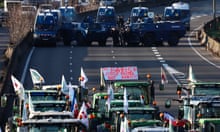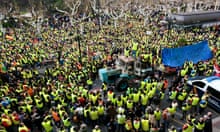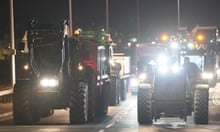It was the worst traffic jam in the history of the Netherlands. From Amsterdam to Eindhoven, Rotterdam to Roermond, more than 2,000 tractors lumbered along clogged highways during the morning rush hour of 1 October 2019. Their spinning beacon lights shining amber through the dark and the rain, they caused more than 1,000km of backups on their way to the seat of government in The Hague. Other tractors made their way slowly through the sand of North Sea beaches. They converged at the Malieveld, a park located close to parliament and the primary royal residence, and a traditional scene of protest. Authorities had said that only 75 tractors would be allowed in the park, but wanting to avoid a direct confrontation, they quickly lifted the restriction. Within hours, 2,200 tractors would be squeezed in, parked front grille to trailer hitch.
The farmers had gathered to protest against an announcement made the previous week. An advisory committee, chaired by the former deputy prime minister Johan Remkes, had declared that the government would need to take “drastic measures” to reduce emissions of nitrogen, a formidable contributor to pollution of land, seas and skies worldwide. By far the largest share of nitrogen deposited on Dutch land comes from agriculture, so these measures would need to involve, according to the committee’s report, buying out and shutting down livestock farms. The report – titled, with a very Dutch combination of understatement and candour, Not Everything Is Possible – did not make clear whether these buyouts would be voluntary or forced. Farmers assumed the worst.
A few tractors broke through fences that had been erected around the Malieveld, and three people were arrested. Otherwise the scene was peaceful. Barbecues were lit and music played. A few enterprising food vendors brought their trailers and did a brisk business selling chips. Signs proclaimed, in English, “No farmers no food”, and “How dairy you”, and in Dutch, “Proud of the farmer”.
Anje Grin, who raises 250 dairy cows on a large farm near the centre of the country, drove her tractor to the protest with one of her employees. “The atmosphere was very nice,” she told me recently. Her husband, Piet, stayed home to look after the farm. “Someone has to stay behind,” he said. “Otherwise I think the demonstration could have been twice the size.”
Remkes’s announcement did not come out of nowhere. Within the 27 member states of the EU, there are a number of specially protected nature reserves, known as the Natura 2000 network. In the summer of 2019, the Dutch council of state, the highest administrative court in the Netherlands, had ruled that the Netherlands’ nitrogen permits system was failing to prevent emissions harming these reserves within its borders, and it needed to end immediately. At the time, this ruling didn’t seem like such a big deal. Major newspapers covered it on page five, or page nine. Alex Datema, who heads the agricultural division of Rabobank, the Netherlands’ second-largest bank, told me that it took dairy farmers “a few months to realise what it meant”.
When the Remkes report hit, everyone woke up. Agriculture was responsible for 80% of emissions of one form of nitrogen pollution, and the report pointed out that the largest share was coming from dairy farming. But dairy accounted for just 1% of GDP. Maybe, the logic went, cutting back on production wouldn’t be such a great sacrifice for the country.
This enraged farmers, who in many cases were already feeling mistreated. They had already reduced their nitrogen emissions by almost two-thirds since 1990, mainly through technical advances. Over the same period, government services in rural areas had been cut in favour of investment in cities. And for more than half a century, government policies had encouraged farms to expand, saddling farmers with debts; now they were being told to do the opposite. “A lot had the feeling that the government betrayed them,” Datema said.
In the days and weeks after the rally at the Malieveld, more demonstrations took place, and rhetoric grew fiercer. Protesters broke down the door of the provincial government in Groningen, a university town surrounded by farmland. A leader of the far-right Farmers’ Defence Force, one of the groups that organised protests, declared that the cabinet wanted “civil war”, an accusation that amounted to a threat.
As strange as it sounds, the government’s failure to develop a workable political solution to the problem of excess nitrogen has shaken Dutch politics to its foundations. In the Netherlands, it is known simply as the stikstofcrisis, the nitrogen crisis. An environmental reform that, at first glance, seemed to affect only a small proportion of Dutch society has somehow become not only wildly controversial in its own right, but embroiled in a web of related and unrelated issues, grievances and conspiracy theories. In 2019, Prime Minister Mark Rutte called it the “fiercest crisis” he had faced as leader, and improbably, it has attracted attention around the world. In the summer of 2022, Donald Trump gave a speech in which he celebrated the Dutch farmers for “courageously opposing the climate tyranny of the Dutch government”. The US rightwing website Breitbart praised the farmers’ resistance against a “green agenda”, and demonstrators in Canada, angry at Covid travel restrictions, waved Dutch flags.

In the Netherlands, far-right groups have seized on the chaos, using the issue to push their own agendas, and two new right-leaning parties (though holding, in a manner peculiar to Dutch politics, leftish elements) – the populist Farmer-Citizen Movement (known by its Dutch initials, BBB) and the centrist New Social Contract – are now polling well in rural areas. Political discontent that coalesced around the nitrogen issue may well determine the outcome of the general election, which takes place on 22 November.
The nitrogen crisis is a story about the political consequences of ignoring a problem for fear of antagonising an important interest group, then fumbling the response when it becomes clear that doing nothing is no longer tenable. And other countries should take note. France, Italy, Germany and Belgium also have Natura 2000 areas that overlap with intensive livestock farming, and without a change in European law, those governments must eventually tackle nitrogen emissions, too. More broadly, as the stikstofcrisis shows, if policymakers cannot devise effective political solutions to urgent environmental problems, they will find themselves in a double bind: watching the natural world fall apart around them, as political upheaval spreads.
At some point in primary school, you probably learned that humans need oxygen to breathe. You may then have been surprised, somewhere between primary school and reading this article, to discover that each breath we take contains far more nitrogen than oxygen. Nitrogen accounts for 78% of the Earth’s atmosphere, and it is perhaps even more surprising that such an abundant element could be one of the greatest sources of pollution worldwide – believed by some to be, after climate change, the most serious environmental challenge we’re now facing.
The nitrogen in the atmosphere is, on its own, harmless. But when it reacts with other elements, it can form more unstable compounds, like the gases ammonia or nitrogen dioxide. Small amounts of both have always been found in the environment, but thanks to human activity over the past 75 years, emissions of the two gases have skyrocketed. Burning fossil fuels emits nitrogen dioxide, which pollutes sky, land and sea, and causes, among other health problems, asthma in children.
Another contributor to our global nitrogen problem is the way we farm. In the second half of the 20th century, around the same time that nitrogen dioxide-emitting cars, planes, power plants and factories proliferated, chemical fertilisers containing nitrogen began to be widely used. Such ammonia-based fertilisers helped to massively improve grain yields. But crops typically don’t absorb all the fertiliser they’re given, because it’s hard to know exactly the right amount to apply. So the excess ammonia runs off into waterways, causing a chain of chemical reactions that decrease oxygen levels in the water and result in “dead zones”, where fish can’t live. As fish populations plummet, coastal economies suffer, too.
Beyond nitrogen-rich fertilisers and burning fossil fuels, there is another key source of nitrogen pollution. Intensive livestock farming contributes significantly to the increase in ammonia. If you crowd too many cows into a field, they’ll eat all the grass before it can grow back. So farmers prefer to put them in barns and feed them concentrated proteins such as soy, which are between 13% and 19% nitrogen. This has increased milk and beef yields, but again, with environmental costs. A cow’s digestive system didn’t evolve to absorb so much nitrogen-containing protein, so the animals excrete a large amount of it. When the animal’s urine and faeces combine, they form ammonia. (This happens more in barns than in fields, because indoors the cows are standing around in the same place all day, rather than spreading their waste over a wider area, so that it combines less.) As with nitrogen dioxide, ammonia floats into the atmosphere, spreading pollution.
These effects cascade. An excess of nitrogen in the soil sets off a chemical chain reaction that depletes the soil’s calcium. Snails use the calcium in soil to form their shells. No calcium, no snails. Snails are, in turn, a crucial source of calcium for birds. Without it, when fledglings try to stand in the nest for the first time, their legs break. That means they won’t grow up to spread fertiliser or seeds through their waste, a process crucial for maintaining forests. Nor – bringing the effects of nitrogen pollution full circle, back to farms – will these birds consume insects and rodents that devour crops. Everyone – plants, animals, humans – loses.
Anje and Piet Grin rise well before dawn every morning, don coveralls or trousers, go downstairs, pull on a pair of wellies left by the kitchen door, and head out to their two barns. It’s a lifestyle that still holds a firm grip on the Dutch imagination. Even today, many city people have parents or grandparents who are or were farmers, and cherish childhood memories of romping about in open fields under skies out of an old master’s landscape painting. In the 20th century, “cities were developed with the idea of integration with the countryside, to give people plenty of fresh air because they don’t have many big parks”, said Geert Mak, who has written several books on Dutch history and culture. More than in many other developed nations, city and country people in the Netherlands have stayed connected, physically and culturally.
Harold Zoet, who raises Welsh ponies and was elected in March to the provincial council of Gelderland on the BBB slate, sees the nitrogen crisis as a manifestation of an emerging divide between urban and rural Dutch. In the Netherlands, and across the world, rural communities have been hollowed out by urbanisation, the mechanisation of farming and plummeting grain prices; and they’ve felt overlooked by politicians perceived to be part of an urban elite. “People don’t understand what it is to work on the land,” Zoet told me. As people feel bad about their increasing separation from nature, he believes, they seek policies to protect it, but are oblivious to how those policies affect rural communities.
The Grins’ farmland, barely an hour’s drive from Amsterdam, was first owned by Piet’s parents, who had 30 or 40 cows along with some crops. When Anje and Piet took over in 1984, they ditched the crops and expanded to 100 cows. In 2012 they expanded again to 250, housing them in a new, state-of-the-art barn designed to limit the amount of nitrogen that gets into the atmosphere. Ever since, they’ve been selling their cows’ milk mostly to a cheesemaker in Germany, 60km to the east.
The Grins are in their mid-60s, and none of their five children is interested in taking over the family business. They want to sell the farm and move to a smaller property nearby where they currently keep a few cattle and tend sugar beets. Theirs is a physically demanding job. “It’s very intense,” Piet said. “There’s a moment when you decide it’s enough.”
The Grins’ farm is what’s known as a piekbelaster – it’s on the government’s list of 3,000 businesses that “cause the most nitrogen precipitation on overburdened nitrogen-sensitive Natura 2000 areas”. That makes them eligible to be bought out by the government. The buyout programme is technically voluntary, but it doesn’t feel that way to the Grins. “What does that mean when you are standing in the corner with the gun pointed at you?” Anje wrote on Facebook in August.
The couple have poured their lives into their farm, and it’s their chief asset. But they can’t continue as they are, and they cannot sell the farm to a private buyer, because the government will not grant a permit that guarantees that the new owner can continue farming. Without that permit, banks won’t grant a loan to any potential buyer. They feel their only option is to accept the government buyout, but that would mean accepting that the barn would be torn down, the animals sold, their life’s work erased.

As part of their retirement plan, the Grins hope to raise a small number of cattle for sale. But they’ve been told that it’s a condition of the buyout programme that sellers no longer farm. They worry that even a few cattle would violate this condition. The government has assured them otherwise, but has refused to confirm this by signing a document drawn up by the Grins’ lawyer. “We’re very afraid that in five years they’ll come back and say: ‘We made a mistake – you can’t have cattle on the second farm.’” (The agriculture ministry won’t discuss individual cases, but says that the buyout programme only bars continued farming at the original location.)
“Farmers want to know they’ll still have a good income in 10 or 15 years,” Zoet said. “They’re looking for a sustainable future.” The Grins, among others, say they can’t see it.
Before he became the head of Rabobank’s agricultural division in May, Alex Datema was a dairy farmer. He still co-owns the operation where his father and grandfather raised cows, and his family’s story encapsulates the remarkable history of Dutch farming over the last 75 years.
In the 1950s, the Netherlands was still recovering from five years of Nazi occupation and the famine that gripped the nation in the final winter of the war. Many of the population were subsistence farmers, with a few cows, a few chickens, some crops, and maybe a pig. Sicco Mansholt, the agriculture minister, decided that the Netherlands could leave behind poverty and hunger by producing enough food to feed itself, rather than relying on imports. Under his proposals, a certain number of farmers would specialise in one product and expand their business, while the government would pay other, smaller farmers to quit. This would mean both that more food could be produced and that the remaining farmers would earn more.
Mansholt’s policies did not pay off immediately. In 1960, GDP per capita still barely exceeded $1,000, 23% less than in the UK. But gradually the plan began to work. The number of Dutch farms plummeted – in 1950, there were 410,000 farms among 10 million Dutch people, while today there are only 55,000 in a population of nearly 18 million – and those that remained became increasingly productive. Since 1984, for example, the number of cows per farm has more than doubled.
Datema’s father and uncle took advantage of subsidies implemented under Mansholt to build new barns, where more cows could be kept on less land. Their cattle herd doubled and they bought concentrates such as soy to feed them more efficiently. Although Dutch farming thrived, Dutch farmers did not have it easy: today many operate on low margins and under heavy debt burdens. “Farmers were more or less forced to expand and intensify, because margins on their produce shrank and the banks that financed them also demanded growth and intensification,” says Caspar van den Berg, a professor of public administration at the University of Groningen.
By 1990, the environmental effects of Mansholt’s policies were also becoming clear. A government commission into the country’s compliance with its nitrogen emissions targets stated that much more needed to be done. The commission acknowledged that nitrogen reductions would create a drop in income for dairy farmers: a typical farm would lose 10,000 guilders a year (about £3,900 today), or about 20% of per capita GDP at the time.
No one wanted to hear this. Since the 1980s, the Netherlands’ coalition governments have almost always included the Christian Democratic Appeal party, which has particular support in rural areas. The party’s leader would almost reflexively be appointed to head the agriculture ministry, which was heavily staffed by the sons of farmers. Despite the 1990 commission, the Christian Democrats successfully kept the issue off the table, and the government continued to encourage farmers to invest and expand.
Dairy production jumped further between 2008 and 2015, as the EU phased out its limits on the amount of milk that individual farmers could supply. By 2020, the Netherlands was home to 3.8 million cows, 11.9 million pigs and 90.2 million chickens in an area one-quarter the size of England, giving it the densest livestock population in Europe by far.
Farmers knew, Datema told me, that perhaps one day they’d have to do more to reduce nitrogen emissions. “But most of them thought, well, if there’s legislation, we’ll do it – but nobody’s really talking about it, besides some people from the environmental groups.” Then, quite suddenly, in 2019, everyone was talking about it.
If the farmers who had driven their tractors to the Malieveld had hoped for a softening of the “drastic measures” that Remkes had declared necessary, they were to be disappointed. In June 2020, eight months after the tractor protest, Remkes held a press conference where he released his final report, with Carola Schouten, the agriculture minister, smiling beside him. Nitrogen emissions would need to be halved within the decade.
The brutality of Remkes’s demand was the consequence of years of inaction. “We knew for a long time about the effect of nitrogen on certain habitats,” Zoet said. “It’s never good to address in such a short term something that built up over a long time.”
To many, the government’s proposals to halve emissions seem both harsh and unworkable; €975m was set aside to buy out piekbelasters like the Grins, and another €500m to buy and shutter other nitrogen-emitting farms. The funds were to come from a pot of €25bn for nature restoration, including nitrogen-emissions reduction. But when the cabinet asked the regional governments to come up with nitrogen plans for their own territory, those plans added up to €58bn.
“If we had started with good legislation 10 years ago,” Datema adds, “it would have been much, much easier to solve the problem than it is now.”
The October 2019 protest on the Malieveld didn’t catch the attention of the far right. The first appearance at a farmers’ protest by Forum for Democracy (FvD), a far-right political party, came four months after the tractor jam. Then Covid hit, and the FvD turned its attention to campaigning against pandemic restrictions and vaccines. But as those restrictions eased and vaccines took effect, and as the farmers’ protests grew more violent, the FvD saw an opening. “Farmer issues lend themselves well to far-right ideology – nostalgia for the past, also their connection to the old Nazi theme of ‘blood & soil’, creating room for the pure white people, all that creepy fascist stuff,” says Léonie de Jonge, a political scientist at University of Groningen.
As the government scrambled to come up with ways to reduce nitrogen emissions, those on the far right, as well as some politicians and farmer activists, tried to undermine any proposals. In May 2020, the agriculture minister proposed limits on the protein content of animal feed. Her opponents loudly insisted that this would lead to cows producing less milk and a resulting decrease in farmer income. They ignored the fact that, as the minister’s press release pointed out, cattle are generally fed more protein than they need, and that the proposed limits were carefully chosen so that milk yields would not suffer.

Conspiracy theorists seized on another part of the press release. Noting the contribution of housing and infrastructure to nitrogen emissions, it stated that “the government considers it important that the licensing of housing construction … does not come to a halt”. This statement seems to have been the basis for the idea, which took off on social media, that the government planned to replace Dutch farms with apartment buildings that would be used to house migrants from Turkey and the Middle East. A former FvD candidate was invited on to Tucker Carlson’s Fox News programme, where she repeated this same conspiracy theory. (She wore a red bandana, a symbol of support for the protesters, tied around her neck.)
In 2022, as discontent with the government intensified, protesters showed up at the home of Christianne van der Wal, the new minister for nature and nitrogen policy (the element had been given its own cabinet post). Stepping out of her front door to confront the men in her driveway, she told them: “My children are inside shaking.” Undeterred, the protesters attacked a police van that had been sent to protect her. One night six months later, in a Ku Klux Klan-style protest, a group carried flaming torches to the home of another cabinet minister.
Alongside such violent actions, fierce but peaceful protest against the government continued. Farmers’ associations and feed companies supplied farmers with Dutch flags to be flown upside down as a sign of displeasure; along many rural roads, upside down flags were placed every 100 metres or so. Alongside their own upside-down flag, the Grins posted a sign on their lawn reading “We are fed up with this policy”.
This year, relations between the government and the agricultural sector have deteriorated further. In June, the largest farmers’ union dropped out of negotiations for an agreement over nitrogen policy, blaming the government’s intransigence. By then, the far right had successfully linked it to the refugee problem. Some rural municipalities wanted to select the nationality of refugees relocated in their communities.
In July, cabinet discussions over reforms to immigration policy collapsed. The government had shuttered all but two of its refugee processing centres; outside the one remaining centre, migrants had slept on the ground and a baby died. This created the impression of a flood of desperate foreigners overwhelming the country. In what many commentators saw as an attempt to appease the right, Rutte argued for tougher restrictions for asylum seekers that would have put the country’s immigration policy in contravention of European law and the Universal Declaration of Human Rights. None of the other parties in the coalition agreed to his proposals. The cabinet talks ground to a halt, and Rutte announced the dissolution of his cabinet.
A few days later, Rutte said that he would not stand for re-election in November. After 13 years in power, he planned to quit politics altogether.
It doesn’t take an expert in public policy or public relations to recognise that the Dutch government has made a mess of the nitrogen issue. Remkes’s recommendation for a “targeted” approach made piekbelasters such as the Grins feel just that – as if they had targets on their backs.
What could the government have done differently? The dairy industry would like to see more pressure on other sources of nitrogen. While the vast majority of current ammonia emissions in the Netherlands are produced by agriculture, 67% of nitrogen dioxide emissions comes from vehicles, and 24% from industry and energy production. “The farms are really under the microscope,” Zoet told me. “I think the government should do more to make other businesses responsible.” But Remkes’s report was clear that nitrogen reduction was not only necessary for farmers. It also targeted the construction industry – another major nitrogen emitter – and proposed other measures, such as lowering the motorway speed limit.
Benjamin Bodirsky, an agricultural economist at the Potsdam Institute for Climate Impact Research in Germany, suggested to me that the government could simply tax farmers on the amount of nitrogen they emit. This would both incentivise farmers to emit less nitrogen, and allow them to reduce emissions in the way that suits them best. “I think you need to leave as much as you can to the farmers themselves and they need to have clarity when it comes to rules of emissions,” says Franciska de Vries, a professor of earth systems science at University of Amsterdam.
Others see technology as the way forward. That was the main driver of the significant ammonia reductions between 1990 and 2010, which have since levelled out. Zoet is enthusiastic about a new system developed by a Dutch company called Lely, which makes robotic farm equipment. This system separates cattle’s waste streams in the barn so that they form less ammonia, then turns much of the ammonia that is formed into fertiliser that the farmer can apply to their own fields with greater precision, so that it doesn’t harm protected areas. The company says that the system reduces ammonia emissions by 70%. Farmers could also add enzymes to feed that help cows absorb more of the nitrogen that they eat, so that less is dumped into the environment.
Yet Natasja Oerlemans, head of food and agriculture at WWF Netherlands, dismisses such notions as sticking plasters. “We need a total rethink of the system,” she says. She and others point out that it’s wildly inefficient to give cattle food such as soy, which is suitable for humans, or to raise them on the kind of land that could instead be producing crops. And if consumers ate more plants, and less meat and dairy, ammonia and greenhouse gas emissions would drop.
There may be no proposal that will satisfy dairy farmers. Any solution for reducing emissions will require either fewer farms, or existing farms to function differently, or both. No solution can guarantee that incomes will be unaffected. As environmental protections become more urgent, it is likely that some people will simply have to change the way they work, just as others might be forced to change how they travel or cook.
But turmoil of the kind seen in the Netherlands might be avoided if politicians act with more care and empathy. Drastic measures may be needed, but it isn’t necessarily helpful to frame them as such, or to place stringent demands on already struggling rural communities. How politicians choose to engage with their opponents is as important as the policies themselves – especially today, when misinformation and disinformation spread with unprecedented speed.
On 30 October, Pieter Omtzigt, leader of the centrist New Social Contract party, debated on TV with Frans Timmermans, the head of a new alliance of leftwing parties. The two men organised the event to show that they could work together to lead a coalition government that could freeze out Rutte’s centre-right party after the November election. Dutch pundits generally regarded the event as a success for both men, and for their parties.
Even if they lead the votes, the two will almost certainly need to pull in another party, or even two, to get to a majority. BBB, now polling fifth, is in an excellent position to play dealmaker – or spoiler – putting an end to Rutte’s party’s dominance.
Whoever wins, the next government will face a host of challenges that have become linked to the nitrogen issue. The Netherlands has 122 job openings for every 100 unemployed; the tram service in Amsterdam has been reduced due to staff shortages, and signs outside virtually every shop seek employees. Migrants are eager to take these jobs, but the government doesn’t have the capacity to process their applications to stay – and there are few places for them to live because of a nationwide housing shortage, exacerbated by the fact that 18,000 construction projects have been halted, because the government wants to restrict their nitrogen emissions. What seems to be a solution to one problem aggravates the others.
This might seem like so much local politics, but the broad contours can be recognised in political trends elsewhere, from the US to Britain to central Europe to the Indian subcontinent. The 2018 gilets jaunes protests in France originated among rural residents displeased with higher fuel taxes, which fell on them disproportionately because they drive more than the inhabitants of cities. Populist politicians are well placed to pick up votes from segments of society that feel abandoned or discriminated against by the government. Van den Berg, the Groningen professor, spoke of the drop in social cohesion in the Netherlands, with public services, public transport and healthcare provisions whittled away in many rural areas. He thinks voters in those places are jumping from one party to another, desperate for anybody to come along and say the government is the problem. On 5 November, Timmermans said he no longer thought it necessary to stick to the current government’s goal to halve nitrogen emissions by 2030.
Though they have been Christian Democrat supporters most of their lives, on 22 November the Grins will be filling in their ballot for the BBB.
This article was amended on 20 November 2023. A previous version said the per capita GDP of the Netherlands in 1960 was 40% lower than that of the UK. It should have said 23% lower. This has been corrected.
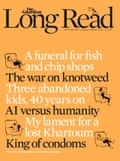
Follow the Long Read on Twitter at @gdnlongread, listen to our podcasts here and sign up to the long read weekly email here.
